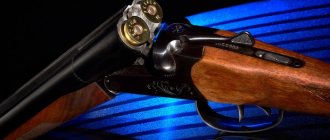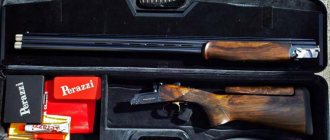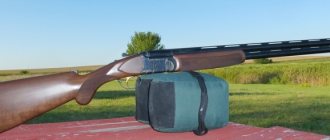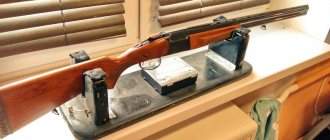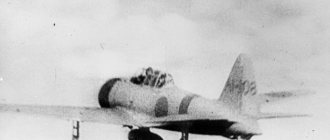The Izhevsk Mechanical Plant, which in 1975 was renamed IZHMASH, and in 2013 became the Kalashnikov Concern, gave Soviet and Russian hunters many excellent hunting rifles. Most novice Soviet hunters first became acquainted with the products of this plant.
Even now, when the Kalashnikov Concern produces a wide range of new hunting shotguns and rifles, the old models are highly valued by experienced hunters. For example, the IZH-12 hunting rifle is still considered the best “over-and-under” in the entire history of the Izhevsk plant. Every hunter who started hunting back in the 70-80s remembers with warmth such a wonderful weapon as the IZH-12. Even many young hunters who managed to shoot with the IZH-12 gun are surprised by its accuracy and reliability.
Signs on Izhevsk guns
Signs, brands and inscriptions on guns are of certain interest not only to gunsmiths, criminologists, historians, but also to the general mass of hunters.
1. Mandatory marking containing information about the caliber, manufacturer, etc.
2. Mandatory acceptance marks, which are actually called brands.
3. Technological markings and stamps, which carry the information necessary for organizing production.
4. Additional markings and inscriptions.
Let's look at these groups in more detail.
Mandatory labeling
in Russia currently includes the manufacturer's trademark, gun number, caliber and chamber length, nominal bore diameter, muzzle constriction of each barrel, symbol of the barrel steel grade, permissible operating pressure in the chambers.
The content of markings and inscriptions on guns is closely related to the traditions of gun production and the history of arms factories in the country, and in Izhevsk in particular.
1.1. First of all, speaking about marking, we should remember the manufacturer’s trademark, which in earlier times was called the plant brand.
The marking of the shield from single-barrel barrels (applied on top of the barrel) was removed in 1986, from double-barrel barrels (applied on hooks and pads) - in 1984. After this, the shield image remained only for the domestic market and was placed on the backs of gun butts. But, it seems, through unofficial channels a certain number of guns with a shield instead of the “Baikal” did end up abroad, especially in the late 80s and early 90s.
In the first half of the 1990s, a new trademark appeared, on which the shield slightly changed its shape, becoming more rectangular. Such a shield can be seen on service, signal and gas pistols and revolvers, and household appliances of the plant. The old shaped shield remained on the guns.
1.3. Designation of choke constrictions.
In 1984, the international (English) Latin alphabet marking system was introduced.
Table 1.
| Muzzle device | Amount of contraction | Designation | Decoding | English designation |
| strong choke | 1.25 mm | T | for trench stand | trap |
| 3/4 choke | 0.75 mm | I.M. | improved | improved modified |
| pay | 0.5 mm | M | pay | modified |
| quarter choke | 0.25 mm | IC | improved | improved cylinder |
| cylinder | 0.0 mm | C | cylinder | cylinder |
| muzzle expansion (flare) | + 0.4 mm | DP(S) | for round stand | skeet |
In foreign catalogs, along with the above designation, there is also the designation of a strong choke XF (Xtra-Full) - “super-full”, a quarter choke as Light Modified - “light pay” and the decoding of the designation of the bell S as Spreader - “diffuser”.
Initially, the English letter S was placed on Izhevsk trunks with a bell, but in 1987. at the insistence of Tula it was replaced with two Russian DR.
In fact, the index of a specific modification is marked, that is, not just IZH-27, but, for example, IZH-27M-1S. Likewise, at the Tula Arms Plant it is not always TOZ-34, but also TOZ-34ER.
Currently, an international system has been adopted, according to which the product of the caliber and the length of the cartridge case, rounded to whole millimeters, is written on one line. The marking will be indicated, for example, as 12x76, although the length of the 3″ chamber is 76.2 mm, or as 7.62x53R, where the letter R means that the cartridge case has a protruding flange.
1.6. Marking of the nominal value of the bore diameter.
Other inscriptions and signs.
Since information about technological markings is extremely scarce and not so interesting, it remains to talk about signs that are mandatory only in some cases and about optional signs and inscriptions.
4.1. The Quality Mark according to GOST 1.9-67 was assigned to different models of guns in different years, for example, on the IZH-26E, it began to be applied since 1970 only to guns intended for the domestic market of the country. This mark is not present on export-made guns sold in the Union. Canceled at the end of 1990.
4.2. The inscription “Made in the USSR” was applied only to the boxes of export-made shotguns, usually in Russian or, at the customer’s request, in English. In March 1992, the inscription was logically transformed into “Made in Russia.” May not be available on shotguns for the domestic market.
4.3. It is probably worth mentioning that manufacturers of double-barreled shotguns from the PMC countries mark their weight on the barrels, but this marking is not mentioned at all in the list of mandatory ones. The meaning of its application is completely unclear; it is not found on Russian-made guns.
4.4. Owner's signs. According to special instructions, inscriptions with the names of importing companies were applied to the barrels of individual batches of guns. For example, on one of the batches of IZH-81 shotguns, on the right side of the barrel, at the request of the customer, the following was written in laser:
IMPORTED BY CAI ST.ALB.VT
please read owners manual before firing
The last line translates to “before use, please read the instruction manual.” Such an inscription is now common not only for American hunting rifles.
Sometimes, for private orders at the factory (and not only), fancy monograms of the owner were applied to the cylinder or trigger guard of the gun. A monogram or dedicatory inscription can also be placed on a special plate embedded in the butt.
That's all that can be said briefly about the inscriptions on Izhevsk guns.
Read cyber fiction online on Phantom Worlds
Source
Question for IZH-58 experts and just owners
On the bottom of my block it says IZH-58MA and there is a USSR quality mark.
I had a 58, the following was written on the bottom of the block: IJ-58MAE. Best regards, CHIZH.
And I just have 58 16k without letters 62g.
This means that the index may not be placed.
There were several articles in the press on labeling. I would like to read them. I'll try to search. As a reminder: if there is a letter in the number, up to 86. If there is a star instead of a shield, it seems up to 61. There were also marks there. Why is it necessary? 58 from MA and M are easy to distinguish by the front contour of the butt.
Still, it’s clear from the design, what difference does it make what they write?
Well I do not know. look for: Blum M.M. Arms factories and stamps of Izhevsk. OiOKH 5-6.93 Valnev V. Signs on guns of Izhevsk fur. N 4-98
My 1966 has this knurl.
In order not to be unfounded, I’ll hang up the photos on Monday, and if I figure out the marks, I’ll write about them.
And on my hunting ticket the date of purchase is 2006. Oh my IZH58 has become rejuvenated.
Grandfather took a new gun, I’m sure: he told me more than once what an epic it was (it lasted almost a year). But even if plus or minus a year is not so important to me. By the way, another question: were IZH-58 12 calibers produced before 1970? We have this in our second-hand store (1964), but it’s in terrible condition, so I’m torn: should I take it for 3500 or not.
Only to them and not only piece ones.
